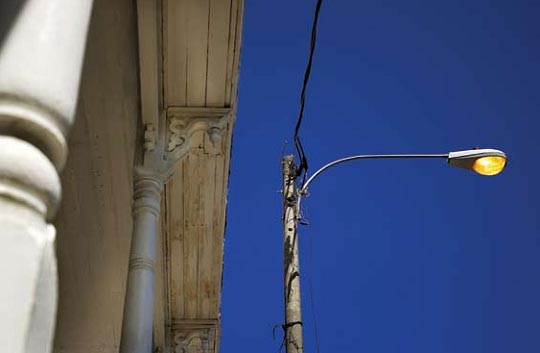
|
The Saint Phillip the Apostle Cathedral (dated 1934) replaced the original parish church, built in stone in
1870. It is located at the highest point of the historic city center. It is not a Victorian edifice as many others
that surround the square are. Rather, its reinforced concrete structure and twin towers impressively represent
Art Deco in Puerto Plata’s architecture. A pastel yellow base with brown-colored rooftops bid parishioners
to pray within.
House #48, Duarte Street. This house was originally built for the Pierret family around 1900. It is a single-floor
traditional house, with hipped roof and eaves, elegantly decorated in wood trimmings.
Commerce Club, #29, Jose del Carmen Ariza Street. Built in 1897, its front facade is bordered by a wide
verandah, from where all the activities that take place in the Central Park may be observed. In its early days
it housed a recreational society and was one of the first places where Merengue music was first played,
way back in 1930. At present, the locale is rented out to a Christian church community. The color white was
chosen for its refurbishment, serving to highlight its elegance. The building was decreed a National Monu-
ment, as it is the most significant example of a Victorian-style edifice in Puerto Plata.
Twin Houses #35-35A, Jose del Carmen Ariza Street. Built in reinforced concrete by Puerto Rican master-
builder Monserrate for members of the Hernandez-Cava family, these houses date back to 1915-16. Even
though they are commonly known as the twin houses, they are not identical, but rather joined by a neo-
classical balcony with a passageway in the middle. A sober cream color with dark brown trimming was
chosen for their exterior.
Land Court, #36 Beller Street. Although today it houses a government office, in its early days the building
was the residence of the family of Nidia Batlle de Paiewonsky. The stonework house was built by Juanito
Acosta around 1928 and replaced an earlier wooden building with a Victorian verandah. It is considered
one of the city’s residences of the “bungalow” variety.
The home of the Loinaz family, also known as Hotel Madrid, located at #38 Beller Street dates back to 1875.
Records show that German businessman C. Klusener lived there, after renting it to the owner, Ildefonso
Mella. Later it would be owned by the Loinaz family that went on to add a second floor at the start of the
20th century.
Now known as the House of Edward, the house at #40 Beller Street was built by Roderick Arthur for Jose
Eugenio Pimentel near 1885. It is catalogued as having one of the most lovely Victorian verandahs in Puerto
Plata. Its facade is decorated by wood trimming in the form of a large fan. It stands out for its new blue
coloring and white edging.
Another house that had been painted months earlier as part of the first Tropical Paints program effort is
|
|
|
